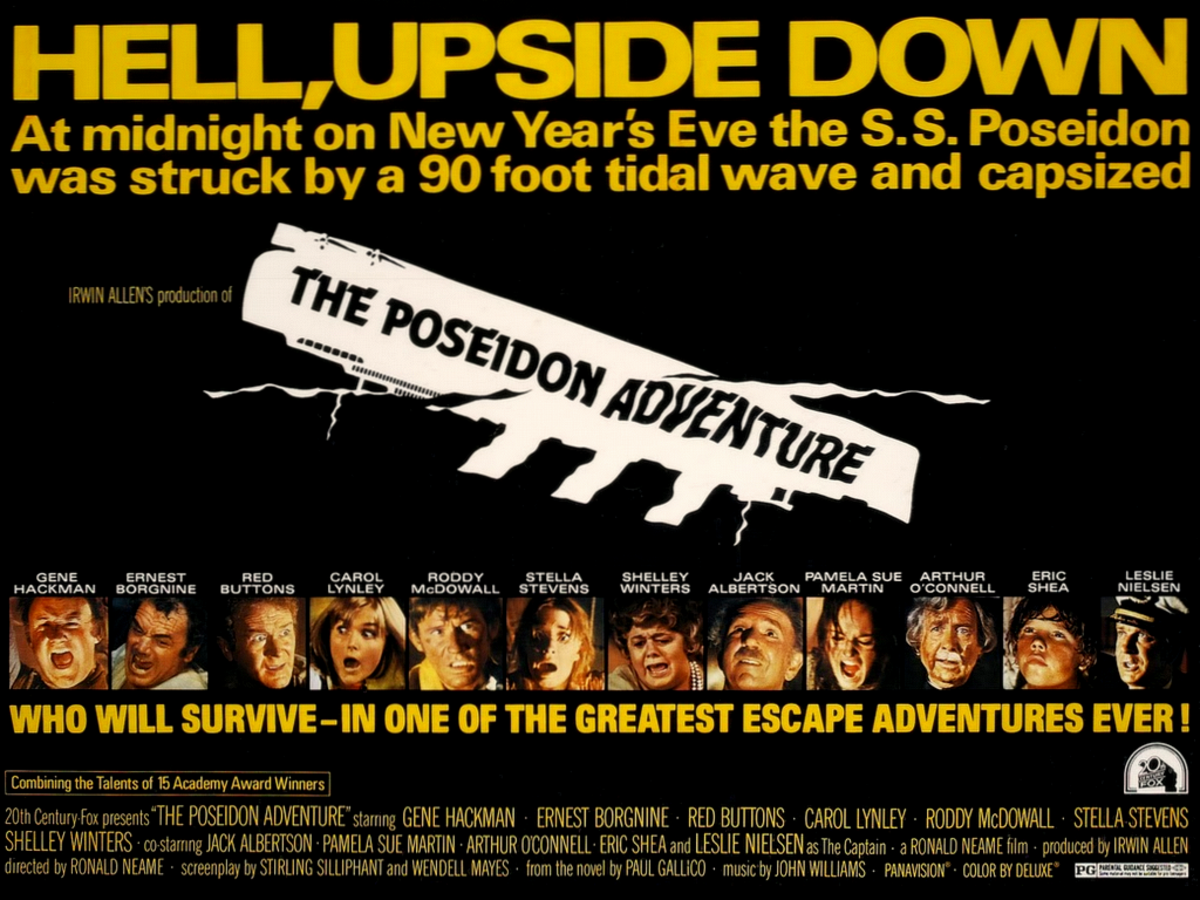
In his book Easy Riders, Raging Bulls, Peter Biskind claims that, putting “Airport, The Poseidon Adventure, Earthquake and The Towering Inferno to one side, the ’70s was a truly golden age.” But while they might have lacked the angst of Five Easy Pieces, the epic sweep of The Godfather and the psychological drama of Taxi Driver, disaster movies produced some of the most memorable screen images of the 1970s. And while he might not have advanced film in the same way as Martin Scorsese, producer/director Irwin Allen did create the genre of film that gave the world the biggest movie of all time, James Cameron’s Titanic.
If Allen had a genius (and the fact that he created TV shows like Time Tunnel and Land Of The Giants suggests that he didn’t), it was realising that life in the ’70s was forever threatened with imminent disaster. The Kent State massacre, Apollo 13, the terrorist attack at the Munich Olympics, a tidal wave in Pakistan that killed 150,000, 168 dead in the Heathrow crash of ’72 – all this and the Vietnam War meant that tragedy was rarely absent from the front pages. Realising, perhaps as Steven Spielberg did with Jaws, that people are quite interested in the things that frighten them most, Allen trampled the boundaries of good taste to create The Poseidon Adventure – the first ever fully-formed disaster movie.
More...
Like many of the films that followed it, you couldn’t describe the plot of The Poseidon Adventure as labyrinthine. Tidal wave hits cruise liner, boat capsizes, band of plucky survivors try to escape – and that was pretty much that. Simplicity of storyline was just one of the many rules of disaster cinema that the Poseidon Adventure laid down. The other regulations were:
1 - Assemble a cast containing one A-list star plus a group of waning B-list celebrities that everyone’ll recognise but not care too much about should they die.
2 - Mix and match a group of survivors from the following archetypes: a born leader (Gene Hackman’s peculiarly bewigged Reverend Scott); a sweet old chap (Red Buttons’ steward); a beautiful woman (The Ballad Of Cable Hogue’s Stella Stevens), a craven coward (The Wild Bunch’s Ernest Borgnine) and a plucky old maid (double Oscar-winner Shelley Winters).
3 - Make sure that nobody listens to anyone who says, “Why don’t we just wait here until somebody finds us?” Remember, fortune favours the brave.
4 - Insist on at least one rather nasty shock moment (in this case involving a cook and a lot of boiling fat).
5 - You’ll need stunts. Lots of stunts.
The action sequences in The Poseidon Adventure are, in fact, some of the best captured on camera, because what you see is pretty much what took place. Without CGI to digitally compose scenes or remove safety wires from the shots, Allen’s stunt directors demanded as much realism as possible. So when you see the ballroom roll over, what you’re looking at is a combination of an elaborate set, intricate model work coupled with death-defying stunt performances. The air of authenticity is further accentuated by Allen’s insistence on shooting in sequence and allowing the principals to perform all but the most dangerous feats themselves. In such a way, the dwindling band of survivors got dirtier and collected more real grazes, cuts and bruises as the shoot progressed.
The scale and success of the action scenes compensated for the problem that’s blighted every disaster movie since – truly abominable dialogue. “Not this woman!” bellows Hackman melodramatically as Winters buys a first-class ticket to the Big Sky, explaining in part why you won’t see this appearing on many critics’ All-Time Top Ten lists. Yet despite a script that was so much dust in the mouths of many fine actors, The Poseidon Adventure continues to be impressive for its overwhelming bleakness. You only have to watch the dangling preacher Hackman cursing God as he’s about to plunge to a fiery death to realise that there was a grittiness to this picture that’s missing from slicker, bigger budget disaster flicks.
But The Poseidon Adventure certainly made bigger box office waves than most movies. Smelling money, Allen set out to top his achievement with 1974’s The Towering Inferno. It matched Poseidon’s take but Allen broke his own rule by employing so many stars that it was impossible to kill them all. Once again, the critics were unanimous in their apathy. Once again, Allen didn’t care and set about dedicating himself to making only more disaster pictures.
And while our Irwin went on to give us films about killer bees (The Swarm) and volcanoes (When Time Ran Out), rival producers began to greenlight pictures about every conceivable catastrophe: extreme seismic activity (Earthquake), all-consuming ants (Phase IV), theme park accidents (Rollercoaster), plane disasters (Airport and its three sequels). Of course, the law of diminishing returns eventually kicked in and the whole fad faded away when the execs discovered new cash cows to milk.
But you can’t keep a good idea down, and when the advent of CGI technology made anything possible in the mid-1990s, the disaster movie was back in vogue. Once again, bad lines were being uttered by good actors as they cowered before the unstoppable force of crashing planes, exploding volcanoes, sinking ships and frisky low pressure weather fronts. Were Irwin Allen alive today (he died, unspectacularly, of a heart attack in 1991) you imagine he’d be very proud. Although given his appetite for work and his somewhat dubious taste, he’d probably be too busy trying to get a picture about the St Jude storm up and running.